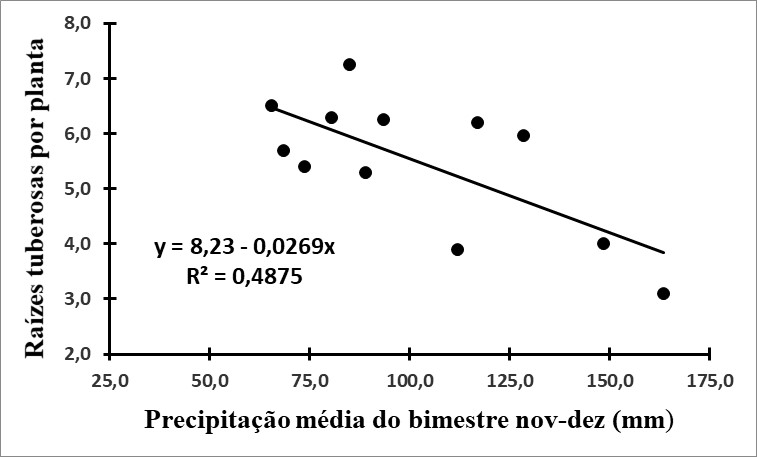Variation in the number of tuberous cassava roots as a function of air temperature and rainfall
DOI:
https://doi.org/10.52945/rac.v38i2.1972Keywords:
Manihot esculenta, climate, storage rootsAbstract
Many factors can influence the number of storage roots per plant (NR) in cassava. In order to verify a possible influence of temperature and precipitation on variations recorded in the NR of cv. Prata, in a sandy soil, regression and linear correlation studies were carried out. A significant inverse correlation was observed between NR and total rainfall in the first three months after planting, and a strong correlation (R = ‒ 0.87) between NR and the total number of days with rainfall greater than 10 mm in the 45 to 85 days after planting (DAP) stage. This inverse relationship may be related to leaching of nutrients in the soil and/or decreased sunlight. Significant and negative correlations were also obtained between NR and average temperatures in October and November. The average maximum temperature of the first 40 DAP explained 53% of the variations in the number of tuberous roots (R = ‒ 0.73), possibly due to physiological stress caused by high air and soil temperatures or water deficiency. It is suggested that additional studies be carried out under controlled cultivation conditions to confirm the results presented. If these results were confirmed, the use of mulch, irrigation or additional fertilization after heavy rains may be management methods to be adopted.
Metrics
Publication Facts
Reviewer profiles N/A
Author statements
- Academic society
- Epagri - Revista Agropecuária Catarinense
- Publisher
- Empresa de Pesquisa Agropecuária e Extensão Rural de Santa Catarina - Epagri
References
DUQUE, L.O.; SETTER, T.L. Partitioning index and non-structural carbohydrate dynamics among contrasting cassava genotypes under early terminal water stress. Environmental and Experimental Botany, v.163, p. 24-35, 2019. DOI: doi.org/10.1016/j.envexpbot.2019.03.023
ELTZ, F.; ROVEDDER, A.P.M. Revegetação e temperatura do solo em áreas degradadas no sudoeste do Rio Grande do Sul. Revista Brasileira de Agrociência, Pelotas, v.11, n.2, p. 193-200, 2005.
FUKAI, S.; ALCOY, A.B.; Llamelo (A.B.; PATTERSON, R.D. Effects of solar radiation on growth of cassava (Manihot esculenta Crantz.). I. Canopy development and dry matter growth. Field Crops Research, v.9, p. 347-360, 1984.
GOMES JUNIOR, F. de A.G. Produtividade de variedades de mandioca em diferentes arranjos de plantio, épocas de colheita, fisiologia do estresse e déficit hídrico. 2018. 78f. Tese (Doutorado em Engenharia Agrícola) - Universidade Federal do Recôncavo da Bahia, Cruz das Almas, BA, 2018.
INTERNATIONAL INSTITUTE OF TROPICAL AGRICULTURE. Cassava in Tropical Africa: a Reference Manual. Ibadan, Nigéria, 1990, 176p. Disponível em: <http://www.iita.org/wp-content/uploads/2016/06/Cassava_in_tropical_Africa_a_reference_manual_1990.pdf>. Acesso em 15 out. 2024.
PARDALES JUNIOR, J.R.; BAÑOC, D.M.; YAMAUCHI, A.; IIJIMA, M.; KONO, Y. Root system development of cassava and sweetpotato during early growth stage as affected by high root zone temperature. Plant Prod. Sci., v.2, n.4, p. 247-251 (1999).
PIPATSITEE, P.; PRASEARTKUL, P.; TAOTA, K.; PONGANAN, S.K.; SAKULLEERUNGROJ, K.; EIUMNOH, A. Effects of surface soil temperature on cassava physiology under diferente water regimes. Naresuan University Journal: Science and Technology, v.27, n.1, 2019. DOI: https://doi.org/10.14456/nujst.2019.2
SHOLIHIN, S. Productivity and stability of cassava promising clones based on the fresh tuber yield in six months using AMMI and GGE biplot. International Journal of Development and Sustainability, v.6, n.11, p. 1675-1688, 2017.
VONGCHAROEN, K. SANTANOO, S.; BANTERNG, P.; JOGLOY, S.; VORASOOT, N.; THEERAKULPISUT, P. Seasonal variation in photosynthesis performance of cassava at two diferente growth stages under irrigated and rain-fed conditions in a tropical savana climate. Photosynthetica, v.56, n.4, p. 1398-1413, 2018. DOI: 10.1007/s11099-018-0849-x

Downloads
Published
How to Cite
Issue
Section
License
Copyright (c) 2025 Augusto Carlos Pola, Alexsander Moreto

This work is licensed under a Creative Commons Attribution 4.0 International License.




